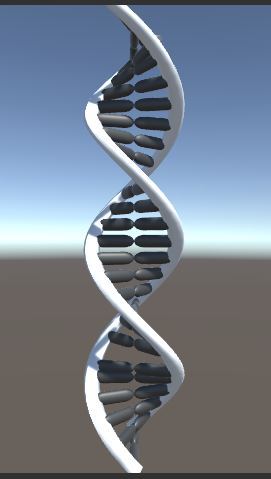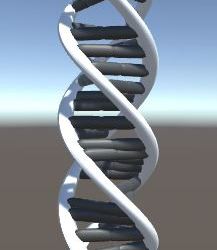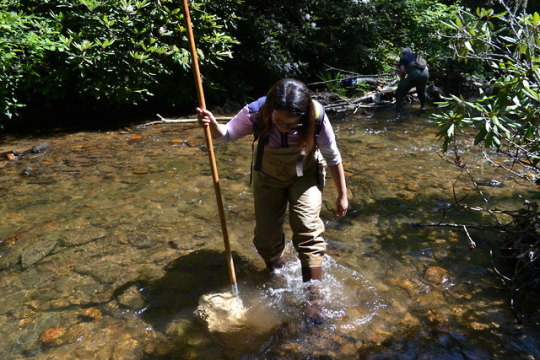#basepair
Explore tagged Tumblr posts
Text

Our ARTEM tool for RNA 3D motif search does not rely on annotated pairwise interactions. Thus, it could identify a D-loop/T-loop-like motif with two non-interacting pyrimidines (U206/U233, right) instead of the characteristic long-range base pair (left).
Find out more: https://doi.org/10.1093/nar/gkad605
0 notes
Text
Whats absolutely sending me about the xfiles is that while the scientific theory of the whacky stuff is solid, the illustrations used are absolutely lukewarm intrductory level stuff that would fool no one with any investment in biochemistry, or even a slightly more detailed memory of high school bio and chemistry.
theyre talking about a protein structure that no one had ever seen before, and then show a picture of the basic model of protein molecule bonds, with placeholder letters because no further detail than "its a protein" is specified by the image. (this one actually made me laugh so much i had to pause watching)
they show a "branched dna" and show a regular double helix (no branches, hasnt been cutting edge technology since the first dna developed in the primordeal soup billions of years ago).
a cool one was the new dna basepair, ngl.
but what baffles me repeatedly is that they will confidently say that a protein is something "they have never seen before" like of course not babygirl, this was the 90s, and they still dont know all the proteins that exist on earth now. the human proteome project is still not even completed. they didnt even know all the human genes in the 90s, and especially not in season 1.
well. just very funny to me, especially because the general theory is genuinely pretty solid.
14 notes
·
View notes
Text
Distance Travel Per DNA Ladder Fragment Size, 1 centimeter distance travel of DNA appear opposite 1500 basepair ladder, while, 1.34 centimeter distance travel of DNA appear opposite 1200 basepair ladder, Whereas, 1.5 centimeter distance travel of DNA appear opposite 1000 basepair ladder, however, 1.7 centimeter distance travel of DNA appear opposite 900 basepair ladder, Meanwhile, 1.9 centimeter distance travel of DNA appear opposite 800 basepair ladder, rather than, 2.2 centimeter distance travel of DNA appear opposite 700 basepair ladder, otherwise, 2.7 centimeter distance travel of DNA appear opposite 600 basepair ladder, While, 3.7 centimeter distance travel of DNA appear opposite 500 basepair ladder., although, 4.9 centimeter distance travel of DNA appear opposite 400 basepair ladder #geneticteacher
0 notes
Link
The companies will integrate Scale's single-cell sequencing data pipeline into Basepair's bioinformatics platform to enable rapid, low-cost single-cell research. #BioTech #science
0 notes
Text
Our lab works on waterfleas and their pathogens. One of our master students crochets little waterflea stuffed animals. Our PI's office is full of them. Our senior lab-tech has hand-reared our entire diversity panel and likes to remind everyone that he will retire when the lab closes and not a minute sooner. Our oldest professor is 82, the university has long since given up trying to get him to retire. He can't really walk anymore and spends the majority of the time napping in his office, but he can identify an immunity gene from basepair sequence by eye. Our PI has been working on waterfleas since the 80s. His advice to us new PhD students when we started was "If you write about what you love, it will be a good paper." Last year someone in this group successfully defended a PhD on the movement of hammerhead sharks. Scientists are all really big fucking nerds, it comes with the territory.
not entirely sure if this is anything, but people discovering that scientists are also nerds and going "oh! they must be one of the rare ones!" always surprises me. Like, what does "nerd" mean to you that you think scientists are boring?
What is a scientist but someone who deeply deeply loves whatever system they're working with? Today I listened to a guy give a presentation on the size of holes in a bee hotel and how that impacts solitary bee species nesting behavior for 20 minutes. Another guy I know who studies dengue fever had a whole slide about "IT IS IMPORTANT TO LOVE YOUR MOSQUITOES OR THEY WILL DIE."
I know people who stand for hours outside studying frogs, people who love microscope imaging, people who develop pipelines and packages, people who camp out overnight to study monarch caterpillar mortality. People who do work on every kind of system imaginable. Would I be here doing tissue culture for six hours a day if I loved no part of it?
I know so many people who pour an incredible amount of love into the work that they do day in and day out often for very slow and minimal returns who are incredibly talented and generous with their knowledge. Can any science really survive without loving what you work with?
Anyway, it's my assumption that very few people go to graduate school or end up in academia because they want to get rich and famous, so what keeps us going year in and year out is the love of what we do.
I work in biology/agricultural science/entomology (insect studies) so my examples draw from there, but I'm pretty sure that all disciplines of scientists are nerds. Like yes, every last one of us. And we love what we do.
(and we'd really really love it if you ask about our study systems.)
#Me tearfully fishing out resting stage eggs out of 35kg of mud 20g at a time (this took 8 weeks): i love my job i love my job i love my job#anyway ur so right Mutual In STEM
77 notes
·
View notes
Photo

Making a little project with a friend ; ) worked on the helix generator and then later on added bridges or actually named base-pairs.

it can even generate alien dna :o with multiple “rims” i call them forgot the word for the spiral like sides.

4 notes
·
View notes
Photo

Stylized DNA monster says nyam nyam #DNA #wip #sketch #simplified #basepairs #scienceillustration #scientificillustration #notabird #art #illustration #cornelllabofornithology
#cornelllabofornithology#dna#notabird#illustration#sketch#scientificillustration#simplified#wip#art#basepairs#scienceillustration
29 notes
·
View notes
Photo

#cute #diagram of #dna #helix #basepairing #adenine #guanine #cytosine #thiamine #genetics #genes #doublehelix #genome #geneticcode #bp #bases #flavors @rougepoptart https://www.instagram.com/p/B3D4moil1Vl/?igshid=fpo1yj7woryf
#cute#diagram#dna#helix#basepairing#adenine#guanine#cytosine#thiamine#genetics#genes#doublehelix#genome#geneticcode#bp#bases#flavors
0 notes
Text
I have truly seen it all. Nucleotide data in a supplementary excel file. Each basepair of each sequence is in a separate column.
2 notes
·
View notes
Text

These recurrent RNA "staple" interactions were reported in our recent paper in Nucleic Acids Research. They are inherently non-planar and not decomposable into base pairs and, therefore remain invisible to existing annotation tools.
Find out more:
https://doi.org/10.1093/nar/gkad605
1 note
·
View note
Text
I tried running a script to convert FastQ file to Fasta
I made it work , however it dumped all my Fasta sequences into the folder without saving it under one file as output! so I ended up having a bunch of sequences floating under the folder!
I tried deleting each junk I made and eventually when I was almost done! I found out that I have deleted my data which I was working on!
#perl#command#line#unix#linux#mac#programming#fasta#fastq#dna#sequence#genomic#gene#basepair#bp#protein#aminoacid
0 notes
Photo


Meet Christine Jewel Yabut, molecular biologist and phylogenist
1) What do you do?
My research focuses on the Phylogeny of an insect group (Trichoptera) that can be found in clean streams and rivers. I discover and describe new species from my group. The species that I discovered from the Philippines were collected in the streams of Los Banos, Laguna inside the University of the Philippines - Los Banos (Diplectrona lagunensis) and in Imugan, Nueva Vizcaya (Hydropsyche philippinensis). During my collection in Imugan, I also collected another new species that was described by a colleague who named the species after me. Cheumatopsyche christinae! I am now finishing a barcode library of the Insect species from the group Trichoptera in South Korea.
2) Where do you work?
I just finished my Ph.D. in Molecular Biology in Korea University last August.
3) Tell us about the photos!
[Left:] This picture was taken in South Carolina, USA when I attended a training for Aquatic Insect collection. I did a teaching assistantship during the period of the summer class.
[Right:] This picture was from Mindanao when I did insect collection from January 21-25, 2014. These amazing local people helped me during my sampling.
4) Tell us about your academic career path so far.
I graduated with a degree in B.S. Biology at the University of the Philippines Baguio. Then I entered Korea University for an integrated M.S. and Ph.D. program. I am now searching for a postdoc position and plan to describe many new species from the Philippines.
5) Anything else you’d like to share?
I am now finishing a barcode library of Korean Insects called caddisfly. This barcode library is like a tag of DNA consisting of 658 basepairs of DNA nucleotide sequences that can be referred to identify the name of the species.
7 notes
·
View notes
Text
Using Transposases for Genetic Engineering
Clustered Regularly Interspaced Short Palindromic Repeats (CRISPR) and CRISPR-associated proteins (Cas) have been repurposed from the adaptive immune system of bacteria as tools to enable genetic engineering. However, Cas9 and Cas12 systems which have been widely employed for genome editing require host cell repair machinery, which can depend on active replication of the cells. As a result, it has largely been limited to nucleotide substitutions.
SBGrid member Feng Zhang and other researchers have been working to use a CRISPR-associated transposase (CAST) in order to harness DNA insertion mechanisms. The researchers investigated a CAST from Scytonema hofmanni and characterized this system consisting of Tn7-like transposase subunits and Cas12k. They investigated its mechanism of RNA-guided DNA transposition and report that the DNA insertions are directed to 60-66 basepairs downstream of the protospacer, without relying on the Cas nuclease activity or endogenous homologous recombination DNA repair pathways in the target cell.
While over-expression of the construct can lead to less specific insertions, particularly into highly expressed genes, it is believed that CAST systems identified in different microbes could exhibit different properties, such as target preference and activity. The therapeutic implications of such systems may include the insertion of corrected exons into an intron before mutated exons to restore gene function.
Read more about this work in Science.
#sbgrid#biomedical engineering#genetic engineering#crispr#member story#science#nature#cell#genetics#crispr-cas
1 note
·
View note
Text
Massive Attack's Mezzanine album as DNA-encoded spray paint
IDEA: Encode music into DNA spray paint.
WHAT: 1 million copies of the Mezzanine album encoded in 901'065 DNA sequences, each 146 basepairs long and encapsulated in silicone particles for long-term storage stability. Limited editions of specially commissioned and manufactured aerosols which contain the DNA of Massive Attack's legendary Mezzanine album. Each can of paint is sold in a unique box, and come with a signed 3D instruction certificate.
Read more about the details of the encoding process here
It’s a creative way to store your back catalogue, although DNA-encoded spray paint is unlikely to be adopted by street artists seeking anonymity. - Robert ‘3D’ Del Naja
WHY: To mark the 20th anniversary of the seminal 1998 album Mezzanine.
BY: Massive Attack, in conjunction with Turboheards Zurich.
#Massive Attack#Mezzanine#Turboheads#Zurich#Robert Del Naja#3D#Painting#Street Art#Graffiti#Sonic Graffiti#Audio Graffiti#DNA
4 notes
·
View notes
Text
Genome
noun
The total genetic content contained in a haploid set of chromosomes in eukaryotes, in a single chromosome in bacteria or archaea, or in the DNA or RNA of viruses.
An organism's genetic material.
The complete genetic information (either DNA or, in some viruses, RNA) of an organism, typically expressed in number of basepairs.
the ordering of genes in a haploid set of chromosomes of a particular organism; the full DNA sequence of an organism
0 notes
Text
Contrast Illumina sequencing and PacBio sequencing technologies
Contrast Illumina sequencing and PacBio sequencing technologies
Please just answer basepair length and their accuracy percent error this is how the question asked on homework Contrast Illumina sequencing and PacBio sequencing technologies Illumina PacBio Read length (in basepair) Accuracy (high/low) Error rate (%)
View On WordPress
0 notes